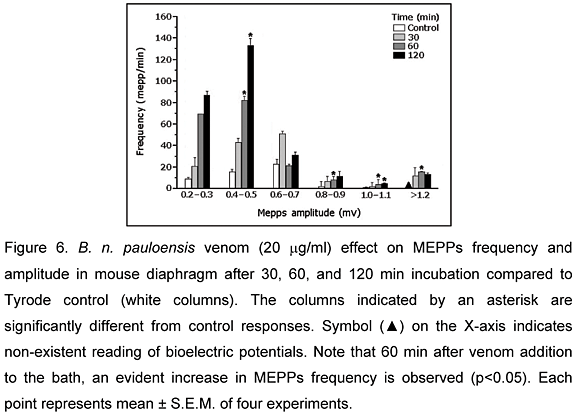The pharmacological effects of Bothrops neuwiedi pauloensis venom on mouse phrenic nerve-diaphragm (PND) preparations were studied. Venom (20 mug/ml) irreversibly inhibited indirectly evoked twitches in PND preparations (60 ± 10% inhibition, mean ± SEM; p<0.05; n=6). At 50 mug/ml, the venom blocked indirectly and directly (curarized preparations) evoked twitches in mouse hemidiaphragms. In the absence of Ca2+, venom (50 mug/ml), produced partial blockade only after an 80 min incubation, which reached 40.3 ± 7.8% (p<0.05; n=3) after 120 min. Venom (20 mug/ml) increased (25 ± 2%, p< 0.05) the frequency of giant miniature end-plate potentials in 9 of 10 end-plates after 30 min and the number of miniature end-plate potentials which was maximum (562 ± 3%, p<0.05) after 120 min. During the same period, the resting membrane potential decreased from - 81 ± 1.4 mV to - 41.3 ± 3.6 mV 24 fibers; p<0.01; n=4) in the end-plate region and from - 77.4 ± 1.4 to -44.6 ± 3.9 mV (24 fibers; p<0.01; n=4) in regions distant from the end-plate. These results indicate that B. n. pauloensis venom acts primarily at presynaptic sites. They also suggest that enzymatic activity may be involved in this pharmacological action.
giant MEPPs; myotoxicity; neurotoxicity; presynaptic action











